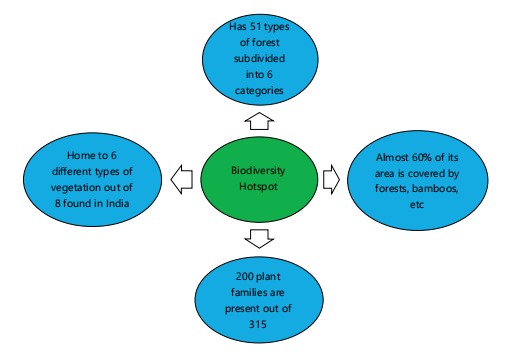Biodiversity in Assam and Northeast India
| Received 18 Apr, 2025 |
Accepted 01 Jun, 2025 |
Published 30 Jun, 2025 |
The Northeastern Region of India is incredibly rich in biodiversity, making it one of the most ecologically diverse areas in the country. This region is home to a wide variety of landforms, including forests, plains, hills, and mountains, each with its unique type of soil and climate. These diverse geographical features create an ideal environment for the growth of numerous plant, animal, and microbial species. The climate in this area further supports the flourishing of a variety of vegetation, contributing to the region’s exceptional natural beauty and ecological significance. In addition to its rich natural resources, the people who inhabit the Northeastern region are known for their hardworking nature. They engage in various forms of agriculture, crafts, and other livelihoods, often working tirelessly every day to support themselves and their families. This close relationship with nature, through their work and daily practices, indirectly contributes to maintaining the rich biodiversity of the area. The activities of the people in these regions, such as farming, forest management, and sustainable practices, play a role in preserving the variety of species that call this region home. Thus, the harmony between the natural environment and the hard work of the local population sustains the region's vibrant and diverse ecosystems.
INTRODUCTION
The word “Biodiversity” comes from two words: “Bio,” which means life, and “Diversity,” which means variety. So, “Biodiversity” refers to the variety of life forms on Earth. It includes all living species found on our planet1. Scientists have divided biodiversity into three main levels: Genetic, species, and ecosystem levels. This classification helps scientists describe species based on the specific regions they belong to, since biodiversity varies across different areas of the Earth2. For example, biodiversity is richest in temperate regions, where conditions like temperature, rainfall, and sunlight are ideal. In contrast, biodiversity is much lower in polar regions, where temperatures are very cold.
Because biodiversity is so vast, scientists believe that even though we’ve discovered about 8.7 million species of plants and animals, there are still many more to be found. Unfortunately, by the time these species are discovered, they may already be extinct due to the ongoing process of evolution3. India, especially its Northeastern Region, has always been home to many species. The Northeastern part of India, made up of eight states: Assam, Arunachal Pradesh, Sikkim, Manipur, Mizoram, Meghalaya, Nagaland, and Tripura- is considered a natural paradise. This region has a wide variety of soil types, altitudes, mountains, slopes, and ecosystems, supporting diverse plant and animal life. It’s also believed to be the cradle of early human life. The area is so rich in biodiversity that it supports about 40 billion people worldwide, including 135 indigenous tribes. Many unique species of plants and animals are found here4.
Assam and the broader Northeast Region of India form a vital yet understudied biodiversity hotspot, home to many endemic and rare species. Despite its ecological wealth, scientific understanding of the region’s flora and fauna, especially in remote and tribal areas, remains limited. Advancing biodiversity research in this area requires an integrative approach that blends modern ecological science with traditional knowledge systems. By emphasizing field surveys, molecular research, and community-led conservation, we can address critical knowledge gaps and promote sustainable environmental policies suited to this unique and fragile ecosystem. This study aims to explore the region’s basic flora and fauna, assess the ecological significance of its biodiversity, and understand the impacts of human activity and climate change.
Hotspot region: The countryside is part of the Indo-Burma biodiversity hotspot, ranked as the 6th out of the 26 hotspots worldwide5. This region is considered a hotspot for the following reasons (Fig. 1).
Types of forests: There are 51 types of forests in the region, grouped into 6 main categories based on climate and vegetation. These categories are:
| • | Tropical wet evergreen forests | |
| • | Tropical semi-evergreen forests | |
| • | Tropical moist deciduous forests | |
| • | Subtropical broadleaf hill forests | |
| • | Subtropical pine forests | |
| • | Temperate forests |
Vegetation in Northeast India: Northeast India is home to 6 out of the 8 different types of vegetation found in India.
Plant families: Out of 315 plant families in India, 200 are found in Northeast India.
Forest coverage: Around 60% of the region is covered by forests, including dense bamboo and pine forests. The Brahmaputra and Barak River valleys provide a habitat for many species.

|
National parks: Northeast India has about 17 national parks, which is a large number for any region.
Crops grown: Rice is the main food in the Northeast region of India, where different types of rice, including indica and japonica species, are grown. In places like Arunachal Pradesh, other crops such as bajra, millets, buckwheat, temperate fruits, and cole are also cultivated. In Manipur, a special type of rice called “Chahao,” known for its black kernels and aromatic flavor, is grown annually, but it is limited due to its low yield. Besides rice, maize is widely grown in the Northeast. Research in the hilly areas of states like Meghalaya, Mizoram, Sikkim, Arunachal Pradesh, and Nagaland shows that 1,250 varieties of maize are cultivated. The region also grows various pulses, 18 types of citrus fruits, different banana and mango species, spices, tomatoes, chilies, ornamental plants, and medicinal plants. Interestingly, 32 species of lemons are found here. Jackfruit is native to Assam, Tripura, and other areas.
Fauna species: The Northeastern Region of India is home to a wide variety of animals, including 3,624 species of insects, 50 species of mollusks, 236 species of fish, 54 species of amphibians6, 137 species of reptiles, 541 species of birds7, and 160 species of mammals. Among the 836 bird species found in India8, about 24 species are unique to this region. The world’s smallest pig, the Pygmy hog, also lives here. Many endangered species, such as the Golden langur9, stump-tail macaque, Northern pigtailed macaque10, and the Red panda, can also be found in this area. Additionally, Arunachal Pradesh is home to four of the six largest cat species in the world: The tiger, leopard, snow leopard, and clouded leopard. The snow leopard is also found in Sikkim11.
A new species of barking deer, called the leaf deer, was recently discovered in Myanmar and Arunachal Pradesh in 200312. The Hoolock gibbon (Bunopithecus hoolock), the only ape found in India, lives in the Northeastern states of Assam, Arunachal Pradesh, Manipur, Meghalaya, Nagaland, Tripura, and Mizoram13. The Namdapha flying squirrel (Biswamoyopterus biswas) is found only in Arunachal Pradesh. Assam has more elephant species than Myanmar, Thailand, Indonesia, or any other Asian country. The brow-antlered deer (Cervus eldi eldi) is unique to Manipur. In Sikkim, there are around 350 butterfly species found at altitudes below 900 m.
Flora species: The region is home to approximately 8,000 out of 15,000 flowering plant species14. This includes 40 species of gymnosperms, 4,000 species of angiosperms, 500 species of pteridophytes, 825 species of orchids, 80 species of rhododendrons, 60 species of bamboo, and 25 species of canes. Additionally, the Northeastern Region of India hosts 800 endangered species, 28 species of conifers, 500 species of mosses, 700 species of ferns, and 728 species of lichens. It is also home to numerous medicinal plant species and 34 species of edible plants.
Arunachal Pradesh and Sikkim are the two states in Northeast India with the highest plant species diversity15. This region is also home to unique species like Clethra sp. and Nepenthes khasiana. Orchids are the most well-known flowers in the Northeast, with the foxtail orchid being the state flower of Assam. The Northeast accounts for more than 57% of India’s total orchid species, and Arunachal Pradesh alone has 545 species of orchids16. Orchids in the Northeast are used for various purposes: In Assam, they are used as ornaments during the Bihu festival, while in Sikkim and Manipur, they are used for food and medicinal purposes17. Most orchid species in the region have medicinal uses. Northeast India also has more than 26 species of cane out of 60 species found in India and 63 species of bamboo out of 150 species in the country. Of these, 25 bamboo species are rare in the Northeast18.
Microbial diversity: The Northeastern (NE) region of India is not only home to diverse flora and fauna but also hosts a wide variety of microbes, including bacteria and fungi that thrive in challenging environments like salt springs, lakes, and wetlands. For instance, 156 actinomycetes with antifungal properties were isolated from the Nambul River in Manipur, exhibiting activity against both human and
plant pathogens19. Additionally, Assam has yielded various antifungal microbes, including the notable Brevibacillus laterosporus MBP3. In extreme habitats such as hot springs, unique microbes known as extremophiles, including Streptomyces manipurensis and Rhodococcus canchipurensis, flourish. Meghalaya is also home to over 700 species of fungal endophytes, such as Heterobasidion perplexans, which play a vital role in decomposition. Some fungi, like Aspergillus spp., are recognized for their antioxidant and anti-inflammatory properties. This rich microbial diversity makes the NE region of India an ideal location for biotechnological research and microbiological studies, highlighting the importance of preserving this unique ecosystem.
Socio-economic and environmental crisis: The Northeastern Region of India is predominantly hilly, with around 30% of its population being tribal people who live on the slopes of these hills. These communities rely heavily on natural resources like wood and timber for their livelihoods, with some even owning their woodland. In the past, this system functioned smoothly, but recent population growth has led to an increase in human activities such as urbanization, deforestation, mining, and agricultural practices like Jhum cultivation20. These activities have significantly harmed the environment and biodiversity, disrupted the tribes' livelihoods, and negatively impacted their socio-economic conditions.
Between 2005 and 2007, the Forest Survey of India reported a significant loss of 201 km² of forest cover, primarily due to shifting cultivation practices, which are a major cause of deforestation in Northeast India. With advancements in science and technology, agriculture and commercial practices have been modernized. However, many farmers and individuals, lacking proper knowledge, have started using chemicals and pesticides to protect crops from harmful insects and meet the growing demand of the population. This has severely impacted the environment and biodiversity. One consequence of these practices is the replacement of native vegetation with commercial plantations, which, along with the use of harmful chemicals as fertilizers, not only degrade land quality but also contribute to the destruction of forest ecosystems.
Poor infrastructure development, current land use policies, and unsafe practices have limited the ability of tribal communities in the Northeast (NE) region of India to adapt, further exacerbating their socio-economic and environmental challenges. Illegal poaching and the trade of wildlife are major contributors to the rapid decline in the population of various species in the NE region. Additionally, a large portion of the population in this area relies on meat consumption, leading to the large-scale killing of wild animals to meet daily demand. As a result, the wildlife population in the NE region is decreasing at an alarming rate.
In addition to the various problems, forest fires, which are a natural issue, are significantly impacting wildlife and plant populations in Northeast India. Due to climate change, forest fires have become a recurring issue in the region, contributing to the decline of plant and animal species. Other challenges, such as human-wildlife conflict, insurgency in states like Assam and Tripura, encroachment, and interstate border disputes, are further exacerbating the socio-economic and environmental crises in Northeast India.
Biodiversity conservation: Biodiversity refers to the variety of life forms present on Earth, encompassing all species of plants, animals, fungi, and microorganisms. The importance of conserving biodiversity cannot be overstated, as it plays a crucial role in maintaining the balance of ecosystems and supporting life as we know it. Unfortunately, due to habitat destruction, pollution, climate change, and various human activities, biodiversity is rapidly declining. The loss of biodiversity threatens not only individual species but also the overall health of our planet and the well-being of future generations. Therefore, must take action to conserve and protect biodiversity to ensure its survival for the future. Biodiversity conservation can be approached at three key levels: The genetic level, the species level, and the ecosystem level. These levels help to ensure that the genetic diversity, species diversity, and the integrity of ecosystems are all preserved for future generations. There are various methods through which biodiversity can be conserved, each tailored to different needs and circumstances. These methods include in situ conservation, ex situ conservation, and agroplasm conservation, among others.
In situ conservation refers to the protection of species in their natural habitats. This method helps preserve species without the stress of being removed from their natural environments, which can often lead to health issues or complications. In situ conservation is typically implemented in protected areas such as wildlife sanctuaries, national parks, and nature reserves, where species are allowed to thrive in their native ecosystems.
On the other hand, ex situ conservation involves conserving species outside of their natural habitats. This approach is particularly useful when in situ conservation is not possible or effective. Examples of ex situ conservation include botanical gardens, zoos, aquariums, and seed banks, where species are housed and cared for in controlled environments. While ex situ conservation is crucial in protecting endangered species, it is typically seen as a supplementary measure to in situ conservation.
Agroplasm conservation focuses on the preservation of plant and animal species that are used in agriculture. This method ensures the genetic material of these species is preserved for future generations, supporting sustainable agricultural practices and food security. By conserving agricultural biodiversity, we can safeguard important crops, livestock, and other organisms essential for human survival.
In addition to these methods, we can also protect biodiversity by creating and maintaining protected areas, promoting the sustainable use of natural resources, and enforcing environmental laws and regulations. Encouraging responsible environmental practices and raising awareness about the importance of biodiversity can ensure that future generations inherit a planet rich in life and natural resources. The conservation of biodiversity is not only crucial for ecological health but also for the continued well-being of all living organisms, including humans.
CONCLUSION
The biodiversity of Northeastern India is under serious threat from human activities, demanding urgent and sustained conservation efforts. Immediate action, including stricter regulations, sustainable development, and rational resource use, is essential to protect this ecological treasure. Preserving this rich natural heritage is a shared responsibility crucial for ensuring environmental balance and securing it for future generations. The rapid deforestation, unregulated development, and habitat fragmentation are accelerating the loss of endemic species and disrupting delicate ecological balances. Without immediate intervention, many unique flora and fauna may also face extinction, compromising both environmental stability and the livelihoods of indigenous communities.
SIGNIFICANCE STATEMENT
This study identified the alarming rate of biodiversity loss in Northeastern India and the underlying human-induced causes, which could be beneficial for designing effective conservation strategies and sustainable development models tailored to the region. The study will assist researchers in uncovering critical areas of ecological degradation and conservation gaps that have remained unexplored by many. Consequently, a new theory on region-specific biodiversity management and sustainable development may be developed.
REFERENCES
- Wilson, E.O., 1988. Biodiversity. National Academies Press, Washington, DC, USA, Pages: 538.
- Nambisan, P., 2017. Biodiversity and Sharing of Biological Resources. In: An Introduction to Ethical, Safety and Intellectual Property Rights Issues in Biotechnology, Nambisan, P. (Ed.), Elsevier, Amsterdam, Netherlands, ISBN: 978-0-12-809231-6, pp: 189-209.
- Sonebi, M. and D. McKendry, 2008. Effect of mix proportions on rheological and hardened properties of composite cement pastes. Open Constr. Build. Technol. J., 2: 15-23.
- Bhutia, S., 2020. Sustainable tourism for regional development in North East States of India: Trends, problems and prospects. Global J. Hum. Social Sci., 20: 21-34.
- Mittermeier R.A., N. Myers, C.G. Mittermeier, 2002. Hotspots: Earth's biologically richest and most endangered terrestrial ecoregions. J. Mammal., 83: 630-633.
- Chatterjee, S., 2008. Biodiversity conservation issues of Northeast India. Int. For. Rev., 10: 315-324.
- Chettri, N., D.C. Deb, E. Sharma, R. Jackson, 2005. The relationship between bird communities and habitat: A study along a trekking corridor in the Sikkim Himalaya. Mt. Res. Dev., 25: 235-243.
- Haider, M.Z., S. Ahmed, N. Sial, G. Afzal and A. Riaz et al., 2022. Avian diversity and abundance of Taunsa Barrage Ramsar site in Punjab, Pakistan. J. Zool. Syst. Evol. Res., Vol. 2022. 10.1155/2022/4736195
- Roy, D. and R. Nagarajan, 2018. Biology, Ecology, and Conservation of Golden Langur, Trachypithecus geei. In: Indian Hotspots: Vertebrate Faunal Diversity, Conservation and Management Volume 1, Sivaperuman, C. and K. Venkataraman (Eds.), Springer, Singapore, ISBN: 978-981-10-6605-4, pp: 251-283.
- Singh, B., Anisur Rahman, N.R. Talukdar and P. Choudhury, 2023. Population, behavior and conservation status of the Northern pig-tailed macaque (Macaca leonina) in the Inner-line reserve forest, Assam, India. Trop. Ecol., 64: 287-295.
- Sathyakumar, S., T. Bashir, T. Bhattacharya and K. Poudyal, 2011. Assessing mammal distribution and abundance in intricate Eastern Himalayan habitats of Khangchendzonga, Sikkim, India. Mammalia, 75: 257-268.
- Datta, A., J. Pansa, M.D. Madhusudan and C. Mishra, 2003. Discovery of the leaf deer Muntiacus putaoensis in Arunachal Pradesh: An addition to the large mammals of India. Curr. Sci., 84: 454-458.
- Nijhawan, S., I. Mitapo, J. Pulu, C. Carbone and J.M. Rowcliffe, 2019. Does polymorphism make the Asiatic golden cat the most adaptable predator in the Eastern Himalayas? Ecology, Vol. 100. 10.1002/ecy.2768
- Arunachalam, A., R. Sarmah, D. Adhikari, M. Majumder and M.L. Khan, 2004. Anthropogenic threats and biodiversity conservation in Namdapha nature reserve in the Indian Eastern Himalayas. Curr. Sci., 87: 447-454.
- Sarmah, R., 2012. Non-timber forest products: Extraction and impact on plant community structure in and around Namdapha National Park of Arunachal Pradesh, India. Indian J. Plant Sci., 1: 192-207.
- Saikia, P., A. Kumar and M.L. Khan, 2016. Biodiversity Status and Climate Change Scenario in Northeast India. In: Climate Change Challenge (3C) and Social-Economic-Ecological Interface-Building: Exploring Potential Adaptation Strategies for Bio-Resource Conservation and Livelihood Development, Nautiyal, S., R. Schaldach, K.V. Raju, H. Kaechele, B. Pritchard and K.S. Rao (Eds.), Springer, Cham, Switzerland, ISBN: 978-3-319-31014-5, pp: 107-120.
- Jahn, L.R., 1988. The potential for wildlife habitat improvements. Int. Soil Water Conserv., 43: 67-69.
- Basumatary, A., S.K. Middha, T. Usha, B.K. Brahma and A.K. Goyal, 2015. Bamboo, as potential sources of food security, economic prosperity and ecological security in North-East India: An overview. Res. Plant Biol., 5: 17-23.
- Mehta, P. K.C. Sekar, D. Bhatt, A. Tewari and K. Bisht et al., 2020. Conservation and prioritization of threatened plants in Indian Himalayan Region. Biodivers. Conserv., 29: 1723-1745.
- Raman, T.R.S., 2001. Effect of slash-and-burn shifting cultivation on rainforest birds in Mizoram, Northeast India. Conserv. Biol., 15: 685-698.
How to Cite this paper?
APA-7 Style
Upadhyay,
R., Upadhyay,
P. (2025). Biodiversity in Assam and Northeast India. Asian Science Bulletin, 3(2), 146-151. https://doi.org/10.3923/asb.2025.146.151
ACS Style
Upadhyay,
R.; Upadhyay,
P. Biodiversity in Assam and Northeast India. Asian Sci. Bul 2025, 3, 146-151. https://doi.org/10.3923/asb.2025.146.151
AMA Style
Upadhyay
R, Upadhyay
P. Biodiversity in Assam and Northeast India. Asian Science Bulletin. 2025; 3(2): 146-151. https://doi.org/10.3923/asb.2025.146.151
Chicago/Turabian Style
Upadhyay, Rishikesh, and Pratiksha Upadhyay.
2025. "Biodiversity in Assam and Northeast India" Asian Science Bulletin 3, no. 2: 146-151. https://doi.org/10.3923/asb.2025.146.151

This work is licensed under a Creative Commons Attribution 4.0 International License.




